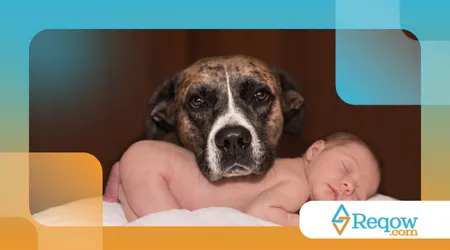Tips for introducing your dog to a newborn baby

Introducing the dog to a newborn baby. Advance preparation is the foundation for harmonious coexistence.
Advertisements
Success lies in small, gradual changes to the dog's environment and routine. Start introducing the baby's smells, sounds, and objects weeks before delivery.
In this sense, this subtle familiarization minimizes the shock of newness for your four-legged friend.
He will associate the new elements with something natural, not a threat to his attention.
Furniture, cribs and layette items can be explored under supervision, transforming them into part of the domestic landscape.
Advertisements
At the same time, the dog's routine should be kept as close to normal as possible, avoiding unnecessary stress.
After all, why wait for the mess to settle in before starting to educate?
Why Desensitization to Sounds and Smells is Crucial for Introducing Your Dog to a Newborn Baby
Dogs have much sharper senses than ours, and a newborn's world is a whirlwind of new stimuli. Desensitization is key to avoiding negative reactions.
Use recordings of baby cries at low volume, gradually increasing the volume over the days. This creates a controlled and positive sound habituation.
Let the dog sniff clothes worn by the baby at the hospital before the actual meeting.
Smell is their primary form of recognition, and this preview establishes a secure connection.
This simple and effective technique is the bridge that prevents the dog from seeing the new scent as something strange or invasive. The dog's calmness is a reflection of your careful and attentive preparation.
What Techniques Ensure a Smooth First Date?
However, the first meeting requires calm, control, and a structured approach. Avoid excitement and rushing, as these can cause anxiety in the dog.
It's essential that the dog has already expended energy during a walk or playtime before contact, and is relaxed. A calm dog is one that processes new information better.
When the mother arrives home, the baby should be held by an adult in a neutral and safe place. The dog should be greeted first with affection and attention to avoid feeling neglected.
Read more: Tips for Keeping Apartment Dogs Active and Happy
The ideal is introduce the dog to a newborn baby with the animal on a leash, allowing the initial sniff in a supervised and brief manner. This restraint prevents jumping and sudden movements.
Remember the crowded elevator analogy: no one likes being forced to interact in a small, noisy space. Bring them together with space and silence.

How to Manage Routine and Space After Arrival?
On the other hand, maintaining a predictable routine is vital for the dog's emotional balance. The baby will demand attention, but the dog shouldn't experience an abrupt loss of affection.
Set aside quality time exclusively for your pet, even if it's just a few minutes of affection or playtime each day. This positive reinforcement is powerful.
Look how interesting: Tips for integrating dogs and cats into the same home
In other words, if the dog had the habit of sleeping on the bed, keep it, but with the door to the baby's room closed initially.
If there is a need to change the resting place, do so weeks in advance.
So, whenever your baby is in the highchair on the floor, use that moment to give your dog a toy stuffed with treats in his bed.
This associates the baby's presence with something pleasant. This intelligent management of space and time avoids jealousy and competition.
What Do Experts Say About Initial Interaction?
According to a study by the American Veterinary Society of Animal Behavior (AVSAB) on introducing babies into homes with dogs, prenatal preparation reduced the chances of unwanted behaviors, such as excessive barking or territorial aggression, by 60%.
Find out more: How to teach your dog to release objects from his mouth
This fact reinforces the importance of a well-executed adaptation plan. Many parents wonder: Will the dog accept the baby?
The answer, overwhelmingly, is yes, with proper mediation. The following table demonstrates the suggested progression for contact:
| Introduction Stage | Objective | Suggested Duration |
| 1. Initial Smell | Olfactory Familiarization | 1 minute |
| 2. Eye Contact at a Distance | Acceptance of Presence | 5 minutes |
| 3. Close Supervision | Controlled Interaction | 10 minutes (short sessions) |
Progression must be done respecting the dog's time and without forcing the issue.
Why Are Constant Supervision and Positive Reinforcement Non-Negotiable?
Supervision is your most important role. Never, under any circumstances, leave your dog and baby alone, not even for a second.
Even the most docile dog can react unexpectedly to a sudden movement or a loud cry, out of instinct or confusion.
Use positive reinforcement (treats, affection, and praise) whenever the dog appears calm in the baby's presence. Create a "store of good associations."
It's crucial that the dog understands that the baby's presence brings good things to him too. This way, we can introduce the dog to a newborn baby peacefully.
The child's safety is a top priority, and the dog's peace of mind is the means to achieve it. Your behavior is your pet's guide.

What Signs of Stress in a Dog Require Immediate Attention when Introducing a Dog to a Newborn Baby?
Recognizing signs of stress is crucial to intervene early and prevent accidents. An anxious dog communicates its need for space.
Excessive yawning, lip licking, averted gaze, tail between legs, or ears back are clear warning signs of discomfort.
If you notice these signs, simply increase the distance between the dog and the baby and redirect the pet's attention to a toy or activity.
Never punish a dog for expressing discomfort. Punishment only masks the problem and can lead to future aggressive reactions.
The goal is for the dog to see the baby as a member of the pack and not as a threat or fear factor.
We need introduce the dog to a newborn baby with emotional intelligence.
In short, the key to success in introduce the dog to a newborn baby is in the preparation, patience and supervision.
Turning this new experience into a routine and associating the baby with positive experiences will ensure a life full of love and security for everyone.
Our mission is to create happy and harmonious homes, where the bond between pet and child grows stronger every day.
Frequently Asked Questions
Is it better to introduce the dog while the baby is sleeping or awake?
It's best to introduce the baby awake but calm. The dog needs to associate the new presence with an active human, but not with a source of noise or agitation.
Should I allow the dog to lick the baby?
Not recommended. Although it's a sign of canine affection, dog saliva can contain bacteria that the newborn's immune system isn't yet ready to fight.
What should I do if my dog shows jealousy?
Increase quality time and walks with your dog, separate from your baby.
Never reprimand jealousy. Instead, positively reinforce good behavior around the child. In severe cases, consult a trainer or veterinary behaviorist.
How long do I need to supervise?
Supervision should be constant and uninterrupted during the first few months, ideally until the child begins to walk and is old enough to understand the rules of interacting with the dog (which usually happens around 3 or 4 years old). Safety comes first.
